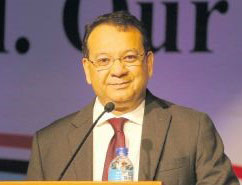(Trinidad Guardian) Energy Minister Franklin Khan on Monday told Parliament that 3,500 permanent workers plus 1,200 non-permanent workers will be affected by the Government’s planned closure of the refinery in two weeks.
Khan gave the overall total in response to questions by UNC MP Rudy Indarsingh. Khan’s figures are the latest total tally of workers to be affected by the plan.
In an August 28 statement on the closure, Petrotrin stated, “Approximately 2,600 permanent jobs will be affected—the redesigned Exploration and Production business will have approximately 800 workers and all 1,700 jobs in refining will be terminated.”
Prime Minister Dr Keith Rowley, in a September 2 address to the nation, had said, “In Refining and Marketing, approximately 1,700 permanent workers will be affected. In Exploration and Production, employment levels are to be reduced from 1,700 workers to approximately 800 persons.”
Company chairman Wilfred Espinet recently reportedly indicated a total of 3,500 permanent workers would be affected. On Monday, however, Khan appeared to give a more complete picture after Indarsingh sought an update on the calculation of the termination benefit packages for all categories of Petrotrin refinery workers and the number of employees to be affected.
Khan replied, “As to the number of employees that will be impacted: the total number of permanent employees impacted from the Petrotrin restructuring and remodelling is approximately 3,500 permanent workers and approximately 1,200 non-permanent workers.”
On benefits, Khan said, “The termination packages and benefits therein are currently being negotiated by the company and OWTU. … I wouldn’t want to prejudge what package they’ll come up with. They have a base and collective agreement and they’ll probably be working on enhancement.”
Indarsingh asked if severance payments would be made for 5,322 workers, which he said was the number of workers in the company given in the Lashley report on Petrotrin. Khan said that report didn’t speak to such activities or severance payments.
UNC’s Roodal Moonilal asked about earlier statements by the PM and Government members which he said put the package around $ 2-3 billion.
Khan said that he’d said the package would be upward of $1 billion.
“If you do basic calculation on the collective agreement, this is obviously more than $1 billion. But the state, board and Government is willing to sit with the union and go through all the numbers and possibly offer some enhancement to that package.”
PM Rowley twice attempted to comment on the matter but was halted by the procedural rules.
Khan was also quizzed on how recent changes to bid rounds issues might affect Petrotrin’s projected Exploration and Production thrust, which is expected to be the restructured company’s money spinner.
After Khan gave the latest figure concerning workers to be affected, Indarsingh told reporters, “A question of trust and credibility has emerged here. When the Prime Minister addressed the nation, the figure given was 1,700 workers, the Energy Minister gave the same initially. Then Petrotrin’s chairman said it was 3,500.
“They need to get their act together. They’re supposed to implement their plan by October 1 but I can’t see all the issues being hammered out. The figures seem to be conflicting.”
Indarsingh said Khan’s become known as a bearer of “fake news” on the issue, since Khan had denied it when word of the refinery ‘s closure first circulated. He called for more information on how many people would be rehired and the criteria for this. Petrotrin’s board speaks at the Hyatt this morning to clarify issues.
With the impending closure of the Petrotrin refinery, Government is moving to activate a national social mitigation plan which targets retrenched/terminated workers.
Social Development Minister Cherrie Ann Crichlow-Cockburn detailed the plan on Monday, saying it was approved by Cabinet in August 2017 and is meant to cushion potential psychological, social and economic effects associated with the economic downturn.
“It targets citizens in vulnerable social-economic positions such as retrenched/terminated workers, unemployed/ low-income citizens at-risk youth, people with disabilities, poor/single household families/individuals and other marginalised groups,” she said.
Its main purpose is to equip people with resources and tools to cope with short-term consequences.
Phase One involves short-term measures:
• Temporary “programming” measures for retrenched workers – food support, public assistance, general assistance grant.
• Extension of the electricity subsidy to include vulnerable retrenched workers.
• Public education Central Bank campaign on financial security.
• Health/Wellness centres.
• Financial/technical support to NGOs providing food and other services to the vulnerable – soup kitchens, temporary shelters.
• Walk-in one-stop facility for people seeking government services.
• Toll-free call centre to disseminate information to those seeking government help.
• Standardised means test to identify the vulnerable sector.
• Phase 2-3 expands provision of training/entrepreneurial opportunities.










